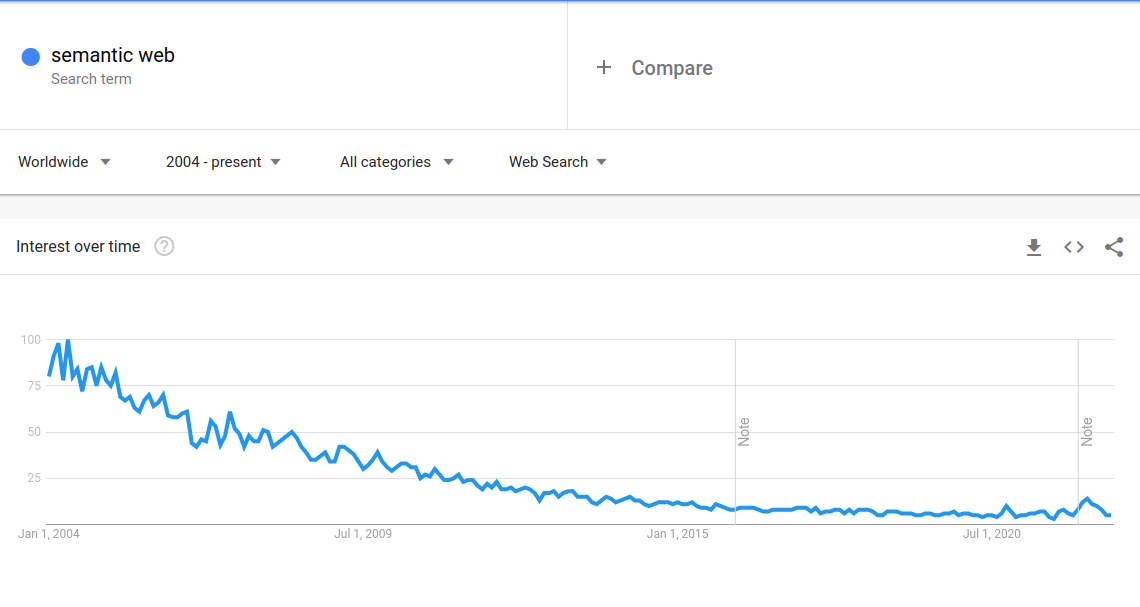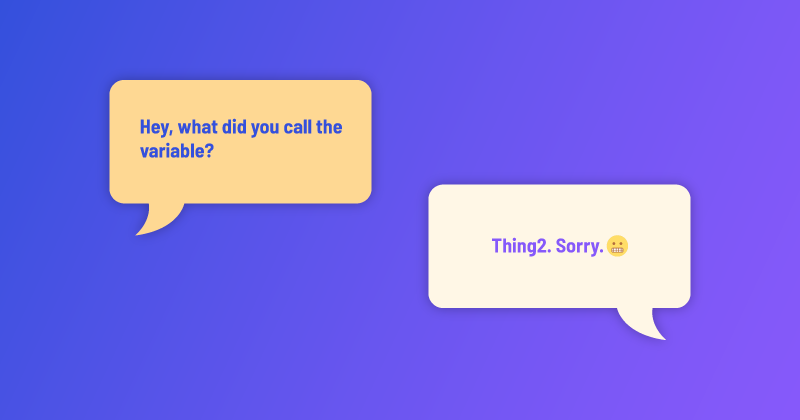The Semantic Web is Dead – Long Live the Semantic Web!
- Gavin
The Semantic Web is rarely mentioned these days, so seldom that the declaration of its death could be met by most of a younger generation of programmers with a question: “The Semantic Who?”

This change in status is significant, but in some ways, the Semantic Web was on life-support since its inception, and it continued to survive only with the medical intervention of academic departments who had no need to produce useable software or solve serious industry needs.
That’s not to say that Semantic Web technologies never served any industry needs. They certainly did so, but their penetration was limited. And this limited penetration was not only the result of ignorance on the part of data architects or software engineers. It was also the fault of deep problems with the ideas in the Semantic Web itself.
Why the Semantic Web is a Great Idea
The Semantic Web’s demise is a tragedy because we need the Semantic Web. But as with all things in life, one must adapt or die, and the adaptations of the Semantic Web were late, ill-advised, and did not address the core problems which led it to be the wrong approach in the first place.
Why do we need the Semantic Web?
Because distributed, interoperable, well-defined data is literally the most central problem for the current and near-future human economy. Knowledge is power, and distributable, actionable knowledge, creates opportunities and efficiencies impossible without it.
We need this. And we do not have this. Yet.
The Semantic Web set out ambitiously to solve this problem, but the problem remains. My experience in engineering is that you almost always get things wrong the first time, then you take that experience forward and fix the core problems. Eventually, you might get something that really sticks.
The analogy of the World Wide Web here is also deeply suggestive of what might be possible. We have an incredible worldwide system of document storage and retrieval, the World Wide Web. These documents are intended to be presented and (since Web 2.0) interacted with. But the problem of getting machines to talk to each other about the most basic records in a sensible way is still open.
The Semantic Web was going to fix this. We would have not only structured documents, but structured data. We would be able to describe not only records, but the meaning of records. The records would allow machines, which could be given access to meaning to infer consequences from the data. We were going to have a rich distributed data environment that would get richer with contributions from people all over the world.
It would be like Wikipedia, but even more all-encompassing, and far more transformational. The effect of the Weather in Ireland on cow prices, would be directly accessible and live, and could be used to compute the likely costs of a steak at the supermarket. Live feeds of wind data could be accessed to provide continental balancing operations for the grid.
In short, the information age needs an information super-highway and not just a big pipe for interactive documents.
Key Innovations
The core ideas and aims of the Semantic Web were largely correct.
We should use a very flexible data structure, and a graph is very flexible. Every data model which is not computation can fit in a graph, and abstract syntax trees can easily represent intended computations.
The ability to reference data resources means that we need large unambiguous identifiers. URIs are able to solve this problem (though there is still much ambiguity about the meaning of the URI and its relationship to dereferencing).
We need a rich language to describe what the content is and what it means. Communicating information about our information is as important as the information itself.
Where it all went wrong
But from here on out, the Semantic Web begins to make some serious errors that basically made it impossible to gain widespread acceptance. And while things are improving inside Semantic Web silos, interest is still waning.
The Format
The first problem is really one that is hard to see without 20/20 hindsight. Triples can be used to describe a labeled graph. That is, we can have three parts, S, P, and O, and use this to denote the origin, labeled edge, and target respectively as is done with N-Triples. It might look something like:
<http://example.com/a> <http://example.com#p> <http://example.com/b>
<http://example.com/a> <http://example.com#name> "a"^^<http://www.w3.org/2001/XMLSchema#string>
<http://example.com/b> <http://example.com#q> <http://example.com/a>
<http://example.com/b http://example.com#name> "b"^^<http://www.w3.org/2001/XMLSchema#string>
This is great because we are representing our graph with long names, presumably within a context where our definitions are under our control. This is important if we want a large world of distributed data. We even have some terminals in our graph with data that can allow us to represent typical data types that we do not want to weave out of the graph individually (Peano arithmetic would be a bit much).
And if we’re lucky, we can make it possible to disclose information about the meaning by attempting to dereference them using the given protocol. Very meta.
This graph above represents a simple loop, but as we can see, is a bit hard for a human to read. We can fix this by defining some prefixes ex: to mean http://example.org/stuff/ and exs: to mean http://example.com/stuff/schema# and xsd: to mean http://www.w3.org/2001/XMLSchema#.
ex:a exs:p ex:b .
ex:a exs:name "a"^^xsd:string .
ex:b exs:q ex:a .
ex:b exs:name "b"^^xsd:string .
That’s certainly a bit better. However, redundancy is not our friend here. It’s easier again to read using the Turtle format, which allows us to refer to prior lines of information as a shorthand. This is good for human readability, but also for computers, which have to read less information (which becomes an issue when graphs are huge).
@prefix xsd: <http://www.w3.org/2001/XMLSchema#> .
@prefix ex: <http://example.org/stuff/> .
@prefix exs: <http://example.org/stuff/schema#> .
ex:a exs:p ex:b ;
exs:name "a"^^xsd:string .
ex:b exs:q ex:a ;
exs:name "b"^^xsd:string .
So far so good. We now have a way (Turtle) to represent graphs that can be communicated. Unfortunately few programming tools have any way of reading this into an easily manipulable data object. XML was a contender, and XML indeed can represent these graphs in an alternative syntax. But XML, despite vastly larger uptake by industry, is falling into disuse itself because it is verbose, hard to read, and similarly hard to manipulate.
While all of this was taking place, JSON was becoming the defacto data interchange standard. Many in the Semantic Web community scoff at JSON and vocally claim it is a mistake. But Vox populi vox Dei.
JSON and the related YAML are among the best data interchange formats. They are fairly easily read by humans, they map directly to vastly popular data structures which are ubiquitous now in programming languages (the associative array) and are extremely well supported for lookup, iteration, pretty printing, and update.
XML by contrast is awful to look at. And neither is it very fun to process XML documents while using a programming language (although prolog actually fits pretty naturally on XML as a query language).
In an alternative world where Lisp won before the AI winter, we might have ended up with S-Expressions, but even these are probably worse as they do not make the naming of the keys mandatory (as opposed to by-position arguments), leading to less readability without having more context.
I’m absolutely positive that some people reading this are going to complain that syntax is just syntax, how things are serialized is superfluous and that a good library can make it easy to use INSERT MY THING HERE. But these people are wrong and their opinions will drift into obscurity the same way that Turtle and XML will. Naming is deeply important, it is no mere triviality, so how much more important is sentence structure?
Of course, there is JSON-LD. This was a very serious attempt to bring Linked Data into the JSON developments and should be applauded. It is, however, needlessly verbose as an interchange format. I’ll explain more later.
JSON and relatives are still expanding in use and will continue to do so. The Semantic Web of the Future must embrace this fact.
The Logic
There are many different and overlapping standards that define Semantic Web technologies, but I think we can focus on OWL which represents one of the most serious attempts to create a formal basis for the description of data.
The idea of representing the structure of data in a data structure that is the same as the data is of course not a new idea (Think S-Exp) but it is a good one. And OWL took this up. OWL is defined to use the same kind of turtle format as above.
The problem with OWL is that it solved a problem, but not one that anyone wanted to be solved. It also did it in a very hard-to-use way. So hard to use that almost nobody has successfully used it. I’ve tried. And I’ve written many machine-checked proofs in everything ranging from Atelier B, through FDR4 to Agda and Coq.
Maybe I’m not the sharpest knife in the drawer, but I’ve written significant proofs in these diverse languages, and never experienced the same pain as with OWL.
What is OWL supposed to do? It’s supposed to be an ontology language. That is, a language that helps us reason about the categories of things, and how they interrelate. It is closely related to Description Logics used in several specialized areas in which the codification is both complex and very important such as biomedical knowledge.
It however makes some fatal errors that impede its use.
Types are easier for programmers to work with than these logical languages. Types are important, not just in low-level and compiled languages, but increasingly in dynamic languages such as python and javascript. Speed is just one benefit of telling the computer what you mean. Another benefit is that the computer can tell you if what you mean is garbage.
And this is why OWL is such a bear. It is very easy to tell OWL you mean something and it just believes you. It provides very little support to the data architect in making sure that things make sense.
For instance, in a programming language, if I define a class A as a subclass of class B, and then define a class B as a subclass of class A, it will most likely complain. In OWL it will just equate class A with class B.
This sort of equivocation by circularity is virtually never what one means. Yet I found numerous examples of these cycles in wild OWL. Nobody noticed them because OWL really had no problem with them, and it is not unless you actually check what inferences arise that you can see the problem.
And this is not unusual. One of the formalizers of OWL said this:
Inconsistencies produce nonsense more than obvious contradictions, and often when long inference chains are followed. @ImageSnippets found one in Wikidata that implied that native Americans are insects, another that Paris is an 'abstract media type'. I'm sure there are more.
— Pat Hayes (@PatHaye67745536) August 7, 2022
The logical approach simply gives the practitioner too much rope to hang themselves, with very little feedback. An advanced researcher can discover these logical conundrums but it is too much mental burden for everyday use.
What caused this problem to arise, and what do we do about it?
Let’s make everything potentially the same
First, not having a unique name assumption is a mistake. Plain and simple. This is the idea that any two URIs might actually mean the same thing unless we explicitly say otherwise. This is a terrible idea for computers in much the same way as it is for humans attempting knowledge representation.
If you want something to be the same you should be forced to say it. Aliasing is a nightmare, computationally expensive, and leads to difficult-to-understand reasoning.
The second mistake serious mistake is the Open World Assumption, the converse of the Closed World Assumption. This assumes that there is as yet ungathered data, forcing us to reason only about what we have at the minute. This might sound like a clever proposal but in practice makes reasoning weak.
Basic things like checking that we have exactly one name for someone become stupidly complicated with the overlap of the above two rules. OWL would rather make two people the same, than complain that you’ve done something wrong.
Things are too Far Apart
It may seem banal and “just syntax”, but when writing large Ontologies, OWL makes you wander far from home when trying to define the meaning of a class. The class requires lots of separately defined properties, each of which is verbose. When you add restrictions to them it becomes even worse: you have to add yet another class that you then intersect with your class to ensure the restriction.
system:Capability
a owl:Class ;
rdfs:subClassOf system:Document, system:CapabilityScopeRestriction ;
rdfs:label "Capability"@en ;
rdfs:comment "A capability confers access to a database or server action"@en .
system:capability
a owl:ObjectProperty ;
rdfs:label "capability"@en ;
rdfs:comment "associates a role with its capabilities"@en ;
rdfs:domain system:Role ;
rdfs:range system:Capability .
system:capability_scope
a owl:ObjectProperty ;
rdfs:label "Capability Scope"@en ;
rdfs:comment "The scope of a capability - the resource that the capability applies to"@en ;
rdfs:domain system:Capability ;
rdfs:range system:Resource .
This may be expressive but extremely annoying and time-consuming. In practice, I’ve seen people completely skip ontologising because the pain barrier was so high specifically for this reason. Making routine tasks time-consuming is a great way to ensure they don’t happen.
Polluting the Data with Inference
While you can use OWL to talk about your data model, you can also use it to enrich your data from the model. This sounds brilliant because we often want calculated information. However, in practice, this is never so nice as a view is in SQL. Why?
The reason is that with a view you create a new distinct resource which is calculated. With clever technology, you can update the data and get a new view updated automatically. Some advanced databases even have ways to insert into a view to update the original tables.
In OWL we entail things into the graph which then looks just like the data from which it was entailed. This makes life complicated when trying to distinguish between the information you got from the real world and information that you got from some chain of reasoning.
And chains of reasoning can be very fraught, and pollute the database. In practice, I often found that things were performed as a batch load process to avoid the problem by restarting with new data. This is of course a ridiculous way to work with a large database.
The dream of computers that reasoned about data as it arrived to create some great symbolic AI, without a Doxastic approach is frankly silly.
Not much in the way of useable constraints, sorry
And we can’t use OWL to provide effective constraints over data. Open World precludes this. We can sometimes say when things are wrong, but we are never sure if things are right. We might always have one more element of a cardinality check that we just don’t know yet.
People who really wanted to use the Semantic Web in industry got fairly fed up with this difficulty and writing individual programmatic checkers and SPARQL queries to patch up the deficiency and eventually invented SHACL.
SHACL goes a long way to alleviating this problem with OWL, but then it doesn’t replace OWL. Instead of giving us a schematic ontology language, we are left with two different languages which must now be kept in sync. Or we ditch the more descriptive partner, OWL, and just use SHACL and move RDF data closer to what is already done in SQL.
This can work and is an improvement to the data stack, but it also loses some of the main appeals of the Semantic Web vision of highly documented metadata about data.
The Right Way (TM) is Right In Front Of Us
Instead of all of this complexity, we should just have a standard schema language, which can be written in JSON or YAML. It should allow us to describe all of the data models in human language. It should make it easy for this to be internationalized.
We could even specify what is derived here explicitly separating constraint from inference. And we should keep derived data segregated from other data so we know the provenance as long as we ensure that properties cannot be either derived or concrete with the user being unable to distinguish.
Already most of those using JSON in anger in industry are focusing on JSON Schema. This solves the easy problems for trees, but not the problems for graphs. It also doesn’t solve the problem of describing the meaning of data or give any help with inference or calculation.
What we need is a Literate Type Theory for JSON, which allows us to specify typed references, giving us the power of graphs, but the simplicity of JSON at the same time.
We should keep the ideas of URIs because without them we will have a very hard time making interoperable data.
But JSON-LD is more heavyweight than necessary. If we have information about our data, then we can know if something is a string or a reference or a collection and what type of collection. We needn’t use something as elaborate as JSON-LD other than perhaps as an elaboration.
The good thing about standards is that there are so many to choose from. — Andrew S. Tanenbaum
I’ve been working to try out some of these ideas at TerminusDB (stars welcome), but for this to work, it needs to be a standard that is widely shared. And for that reason, we need a standard. We need a movement to revitalize the Semantic Web with ideas that primarily serve to do work.
Luckily, there is renewed interest in Semantic Web-like ideas in industry, but industry is not looking to the Semantic Web or to academia to solve them. It’s looking to find them in the ideas of the Data Mesh.
Academics and Industry
The political economy of academia and its interaction with industry is the origin of our current lack of a functional Semantic Web.
Academia is structured in a way that there is very little incentive for anyone to build usable software. Instead, you are elevated for rapidly throwing together an idea, a tiny proof of concept, and to iterate on microscopic variations of this thing to produce as many papers as possible.
In engineering, the devil is in the detail. You really need to get into the weeds before you can know what the right thing to do is. This is simultaneously a devastating situation for industry and academia. Nobody is going to wait around for a team of engineers to finish building a system to write about it in Academia. You’ll be passed immediately by legions of paper pushers. And in industry, you can’t just be mucking about with a system that you might have to throw away.
We have structured collaboration as the worst of both worlds. Academics drop in random ideas, and industry tries them, finds them useless, and moves on.
I’m not sure precisely of the right solution to this problem, but I think it genuinely has to change. Innovation in industry is rare and hard since deep tech is so high risk. And innovation in academia is as likely to be pie in the sky as the next big thing because nobody has the capacity to work through the differences between the two.
The Future of the Semantic Web
The Future of the Semantic Web is there, the Semantic Web will rise, but it will not be the Semantic Web of the past. Humanity’s access to data is of ever-increasing importance, and the ability to make resilient and distributed methods of curating, updating, and utilizing this information is key. The ideas which drove the creation of the Semantic Web are nowhere near obsolete, even if the toolchain and technologies which have defined it up to today are fated to go the way of the dinosaur.
Table of Contents

Many Worlds: A Philosophy of Data Collaboration
An analytic philosophical take on what data collaboration is and how we should think about it.

What if MongoDB and Neo4j had a baby?
This article is about how MongoDB and Neo4j have taken the app-building space by storm & how we aim to give you the best of both worlds.

What’s in a name: URI generation and unique names for objects
Naming things is hard! We’ve encountered many difficulties trying to create URIs in RDF. This article looks at URI naming strategies to make your job easier.